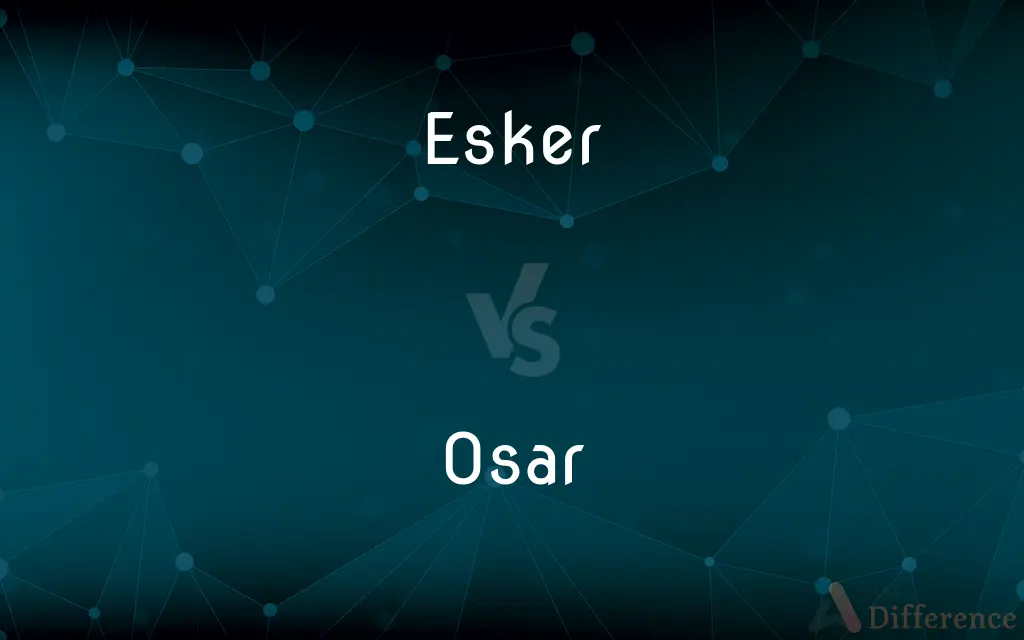Esker vs. Osar — What's the Difference?
By Tayyaba Rehman & Maham Liaqat — Updated on April 9, 2024
Eskers are long, winding ridges of sand and gravel formed by retreating glaciers, while osars are smaller, localized versions of eskers, often found in groups.

Difference Between Esker and Osar
Table of Contents
ADVERTISEMENT
Key Differences
Eskers form as a result of sediment deposition by meltwater streams flowing beneath glaciers. These geological formations appear as long, snake-like ridges, often stretching for kilometers, marking the path of subglacial streams. On the other hand, osars are smaller-scale versions of eskers. They are typically shorter and may occur in clusters, indicating multiple, localized meltwater channels rather than a single, extensive system.
Eskers serve as significant geological indicators of past glacial activity, revealing the direction of glacier movement and the location of meltwater channels. Osars, while similar in origin, provide more detailed insights into the variability and dynamics of glacial meltwater flow, especially in complex glacial environments where multiple streams might have formed parallel or intertwining paths.
In terms of ecological impact, eskers often influence the local hydrology and can be sources of aquifers, supporting diverse ecosystems along their lengths. Osars, due to their smaller size and more scattered distribution, may influence local topography and water drainage patterns on a more localized scale, affecting vegetation and wildlife habitats in specific areas.
The study of eskers contributes to understanding broad patterns of glacial movement and meltwater management over vast areas. In contrast, research on osars can offer more granular details about the behavior of glacier margins and the intricate network of subglacial tunnels that formed them, providing a complementary perspective on glacial geology.
Although both eskers and osars are products of glacial action, their differing scales and patterns of formation reflect the complexity and diversity of processes occurring beneath glaciers. Eskers, with their extensive reach, highlight the power and scope of glacial forces, while the more numerous and varied osars underscore the dynamic and often unpredictable nature of glacial meltwater flows.
ADVERTISEMENT
Comparison Chart
Size
Long, can extend for kilometers.
Smaller, more localized.
Formation
Formed by sediment deposition in subglacial tunnels.
Smaller-scale versions of eskers, often in groups.
Indication
Indicate the direction of glacier movement.
Indicate localized meltwater channels.
Ecological Impact
Can create aquifers and support diverse ecosystems.
Influence local topography and water drainage.
Research Value
Provide insights into broad glacial movements.
Offer details on glacial margin behavior.
Compare with Definitions
Esker
A long ridge of gravel and sand formed by glacial meltwater.
The esker stretched across the landscape, a remnant of the last Ice Age.
Osar
A small esker, often found in groups.
The field was dotted with osars, each telling a story of ancient ice flows.
Esker
A natural aquifer source.
The village sourced its water from an esker.
Osar
Indicator of localized subglacial streams.
Osars in the area hinted at a network of meltwater channels.
Esker
A geological indicator of past glacier paths.
Geologists studied the esker to determine the glacier's direction.
Osar
A focus for detailed glacial research.
The study concentrated on osars to understand meltwater dynamics.
Esker
A habitat for diverse ecosystems.
The esker was home to a variety of plants and animals.
Osar
Affects local drainage patterns.
Water flowed around the osars, affecting the area's hydrology.
Esker
A subject of glacial geology research.
His thesis focused on the formation processes of eskers.
Osar
Influences on local topography.
The osars created a series of small hills and valleys.
Esker
An esker, eskar, eschar, or os, sometimes called an asar, osar, or serpent kame, is a long, winding ridge of stratified sand and gravel, examples of which occur in glaciated and formerly glaciated regions of Europe and North America. Eskers are frequently several kilometres long and, because of their uniform shape, look like railway embankments.
Osar
Plural of os3.
Esker
A long, narrow, steep-sided ridge of coarse sand and gravel deposited by a stream flowing in or under a melting sheet of glacial ice. Also called os3.
Osar
An esker.
Esker
A long, narrow, sinuous ridge created by deposits from a stream running beneath a glacier.
Osar
See 3d Os.
Esker
(geology) a long winding ridge of post glacial gravel and other sediment; deposited by meltwater from glaciers or ice sheets
Common Curiosities
What creates an esker?
An esker is created by sediment deposition from meltwater streams flowing beneath a glacier.
Can eskers and osars provide freshwater sources?
Yes, both can influence the local hydrology and potentially serve as sources of freshwater.
How do eskers affect the ecosystem?
Eskers can support diverse ecosystems by creating unique habitats and influencing local water resources.
What does the presence of an esker indicate about a landscape's geological past?
The presence of an esker indicates past glacial activity and the direction of glacier movement.
Can the study of eskers help predict future glacial movements?
Studying eskers can improve understanding of glacial processes, potentially aiding predictions of future movements.
Are osars always found in groups?
While not always, osars are often found in groups, indicating multiple meltwater channels.
Why are osars important for local topography?
Osars can influence water drainage patterns and vegetation, impacting local topography.
How do osars differ from eskers in terms of size?
Osars are smaller and more localized compared to the extensive length of eskers.
What research opportunities do osars offer?
Osars provide detailed insights into the dynamics of glacial meltwater and the behavior of glacier margins.
What is the difference in ecological impact between eskers and osars?
Eskers can support larger and more diverse ecosystems due to their size, while osars impact local ecosystems on a more localized scale.
Can osars be used to trace the extent of historical glaciers?
Yes, osars can help trace the extent and flow paths of glaciers, offering clues about historical ice coverage.
How are eskers mapped and studied?
Eskers are mapped through aerial photography, satellite imagery, and field surveys to study their formation and ecological impact.
Do osars have any commercial value?
The gravel and sand in osars can have commercial value for construction and landscaping.
What challenges do researchers face when studying eskers and osars?
Access and preservation of these formations in remote or developed areas can pose challenges.
How do eskers and osars contribute to our understanding of climate change?
They provide evidence of past climate conditions and glacial responses to temperature changes.
Share Your Discovery

Previous Comparison
Poa vs. Pod
Next Comparison
Custard vs. TrifleAuthor Spotlight
Written by
Tayyaba RehmanTayyaba Rehman is a distinguished writer, currently serving as a primary contributor to askdifference.com. As a researcher in semantics and etymology, Tayyaba's passion for the complexity of languages and their distinctions has found a perfect home on the platform. Tayyaba delves into the intricacies of language, distinguishing between commonly confused words and phrases, thereby providing clarity for readers worldwide.
Co-written by
Maham Liaqat













































